When elderberry season is here I want to make ALL the elderberry things. But this year I wanted something a little more simple. Ever since I made my fermented honey garlic and fermented honey cranberries I’ve been wanting to do more honey ferments. They are so easy and fun to do, plus have tons of medicinal benefits. So the first thing that came to mind was to make fermented elderberry honey!
Wildcrafting Weeds
If you want to learn more about the edible and medicinal weeds that surround us and how to use them, check out my eBook: Wildcrafting Weeds: 20 Easy to Forage Edible and Medicinal Plants (that might be growing in your backyard)!
Gather & Root Online Foraging Course
My online foraging course is a great way to learn about wild edible and medicinal plants! Sign up to learn more about the gather + root online foraging course here.
Elderberry Benefits
Why would you want to ferment elderberries in honey?
Elderberries are antiviral and antioxidant making them a powerful stimulant for the immune system. They are best used when you know that you’ve been exposed or at the first onset of a cold or flu.
Elderberry can reduce the duration of illness considerably and also helps with coughs and congestion.
Elderberry syrup is a very helpful for keeping our immune systems healthy!
Raw honey also has medicinal benefits on its own, and when it’s fermented it gives you even more beneficial bacteria that will help to prevent sickness.
Elderberry Safety
Elderberries are easy to forage for and grow in many locations. They have become very popular in recent years due to their immune boosting potential.
It’s important to remember that elderberry stems, leaves, and unripe berries are toxic. Be sure to remove all of those before making this recipe. The easiest way to remove the berries from their stems is to freeze the clusters whole, then once they are frozen the berries pop right off.
Red elderberries should not be used in this recipe, as they are toxic when raw.
Black and blue elderberries sometimes have a tiny amount of toxicity when raw, mainly in the seeds, which can cause stomach upset in some people.
The fermentation process in this recipe removes any small amount of toxicity that may be there. Out of an abundance of caution I recommend straining out the berries before consuming the fermented elderberry honey.
Fermented Elderberry Honey Recipe
The moisture content in fresh elderberries when combined with raw honey, along with the natural yeast that is present on the surface, will create an environment that is perfect for fermentation.
Simply combine fresh elderberries in jar with raw honey.
Cap it with a lid (use parchment paper in between if you are using a metal lid) and turn it over for 30 minutes or so to coat all of the elderberries with honey.
Then turn upright and loosen the lid a bit to let fermentation gases escape. Let it ferment in an out of the way spot and in 2-3 days you should start to notice some bubbles forming.
It helps to tighten the lid and turn the jar for the first few days, just remember to re-loosen the lid afterward.
After a few weeks, you will really start to see a lot of bubbles! At this point, it is ready to use. Strain out the elderberries before consuming.
Using Dried Elderberries
You can use dried elderberries instead of fresh if you would like, but they will need to be rehydrated in water before combining with the honey. Otherwise it’s just an elderberry infused honey, which is also beneficial and nice, but not fermented.
My favorite place to get organic dried elderberries is Mountain Rose Herbs.
Let me just say this: this fermented elderberry honey is so delicious!
It definitely does not taste like medicine, more like something that you would put on top of ice cream. Yum!
I love combining all of my favorite things like this. Take a foraged ingredient like elderberries and fermenting it into delicious tasting herbal medicine!
Elderberries are such an important part of anyone’s herbal apothecary, and this is probably my new favorite way to use them.
This is one recipe that you will definitely have to try this season – trust me!
I have some exciting news! My book, Healing Herbal Infusions, is available right now! It includes all types of infusion recipes including a few honey ferments similar to this one. Woo hoo!
More Elderberry Recipes
Show your immune system some extra love and discover your favorite way to enjoy elderberries!
- Fermented Elderberry Soda
- Immune Boosting Tea with Elderberries
- Elderberry & Echinacea Tincture
- Elderberry Mead
Fermented Elderberry Honey
Ingredients
- 1 cup fresh black or blue elderberries (do not use red elderberries)
- 1-1.5 cups raw honey
Instructions
- Put the elderberries into a pint sized mason jar, then add the honey to cover the berries leaving at least an inch of head space at the top of the jar.
- Cap the jar with a plastic storage lid or use a piece of parchment paper underneath the metal lid. Invert the jar for about 30 minutes or longer to make sure that all of the elderberries are coated with honey.
- Turn the jar upright again. After the elderberries and honey have settled and all of the air bubbles are gone you may need to add a bit more honey to cover the berries.
- Loosen the lid to allow air to escape during fermentation and place the jar somewhere out of the way. For the first 2-3 days it is helpful to invert the jar daily then turn it upright again. Be sure to tighten the lid before inverting then loosen again once upright.
- Within about 2-3 days (could be longer in cooler temperatures) you should begin to see small bubbles on the surface and the honey will be noticeably runnier.
- After one or two weeks you will see a lot of bubbles! Give it a stir now and then and it will really bubble up. The honey is ready at any point after this and will continue to slowly ferment for weeks and months.
- Strain out the elderberries before consuming.
- Take a spoonful two to three times per day when you feel a sickness coming on to shorten the duration of a cold or flu.
Notes
- You can use dried elderberries instead of fresh if you would like, but they will need to be rehydrated in water first before combining with the honey.
- Serving: Take a spoonful two to three times per day when you feel a sickness coming on to shorten the duration of a cold or flu.


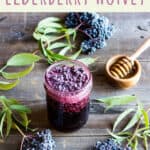
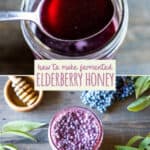

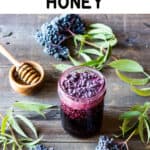
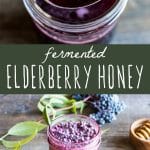
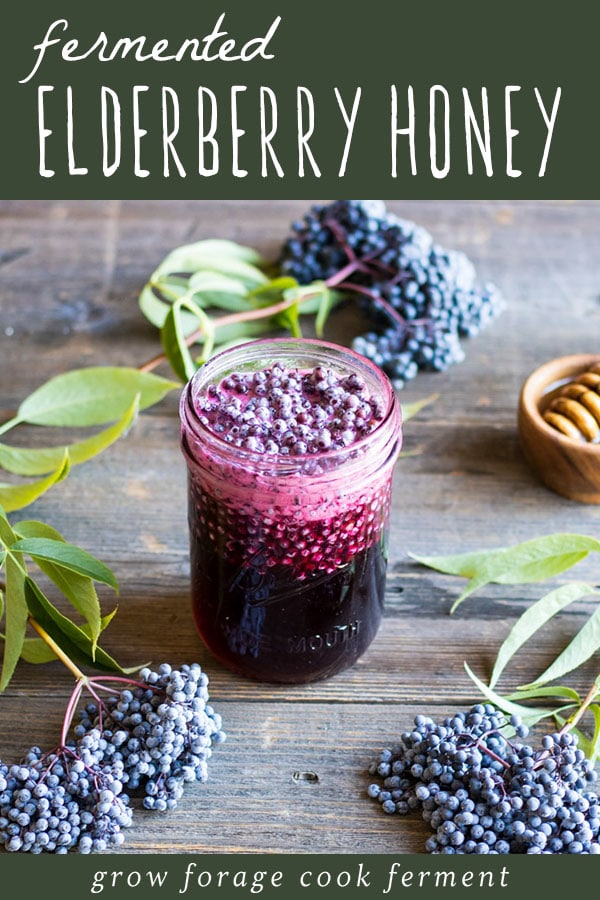
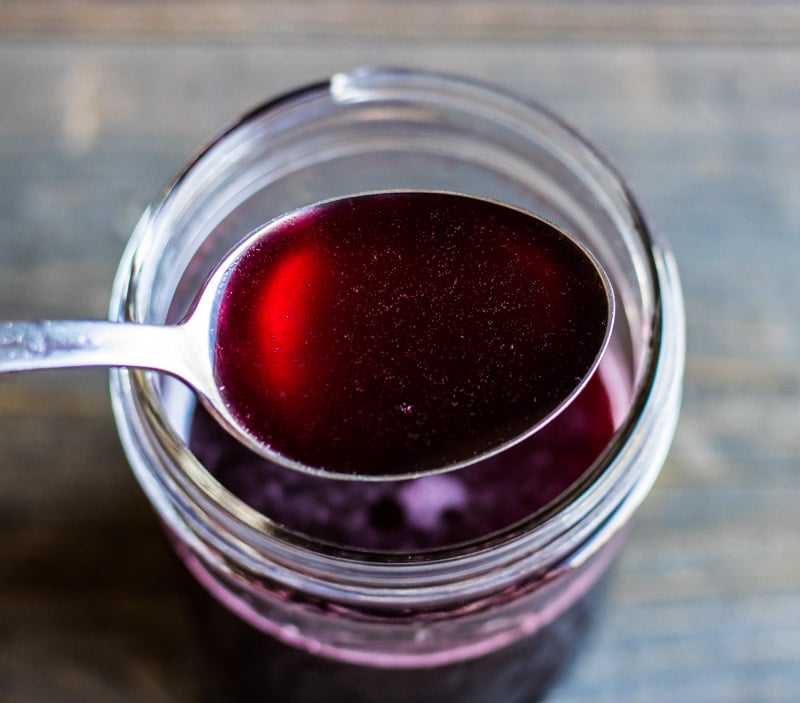
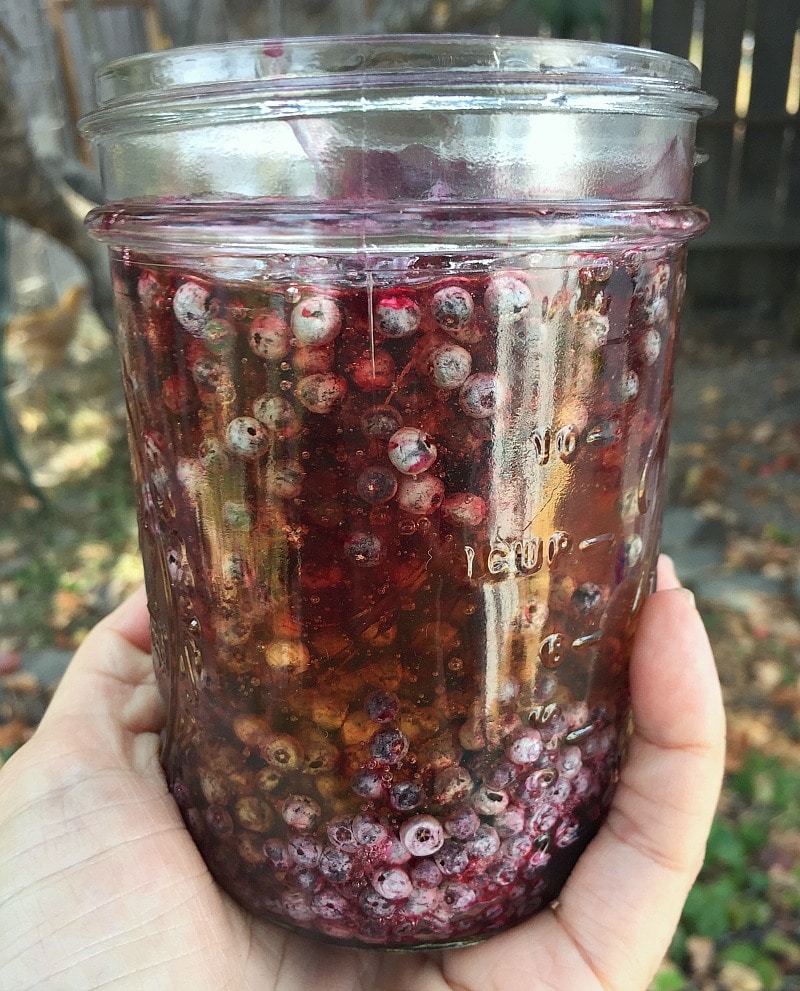
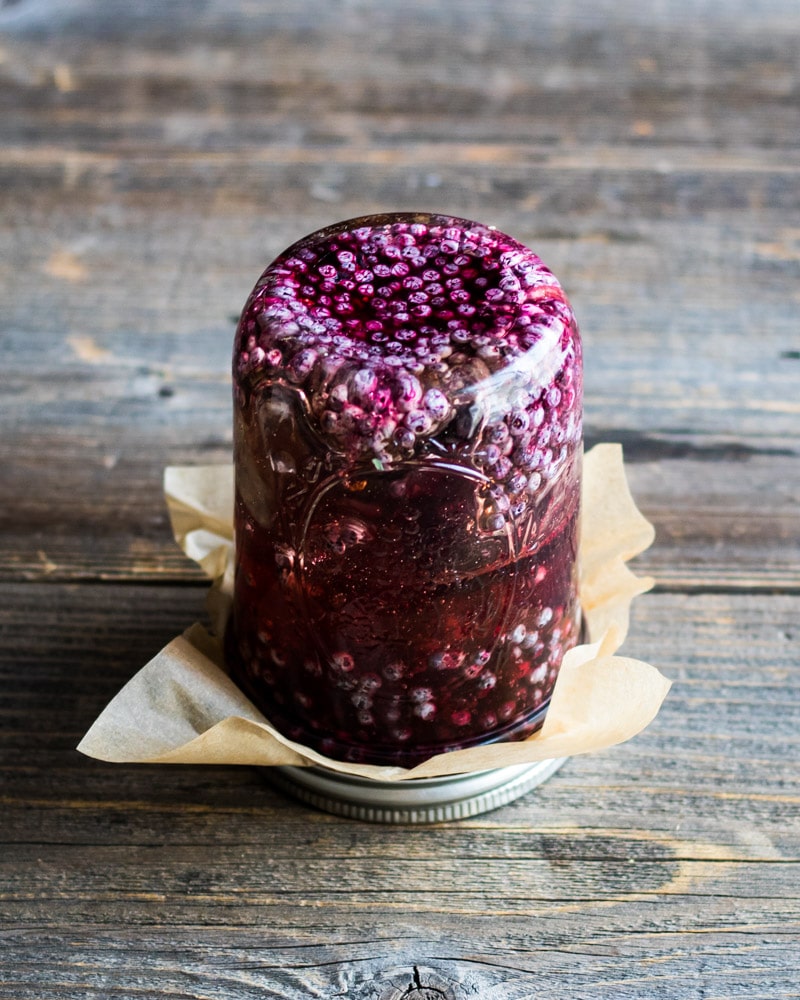
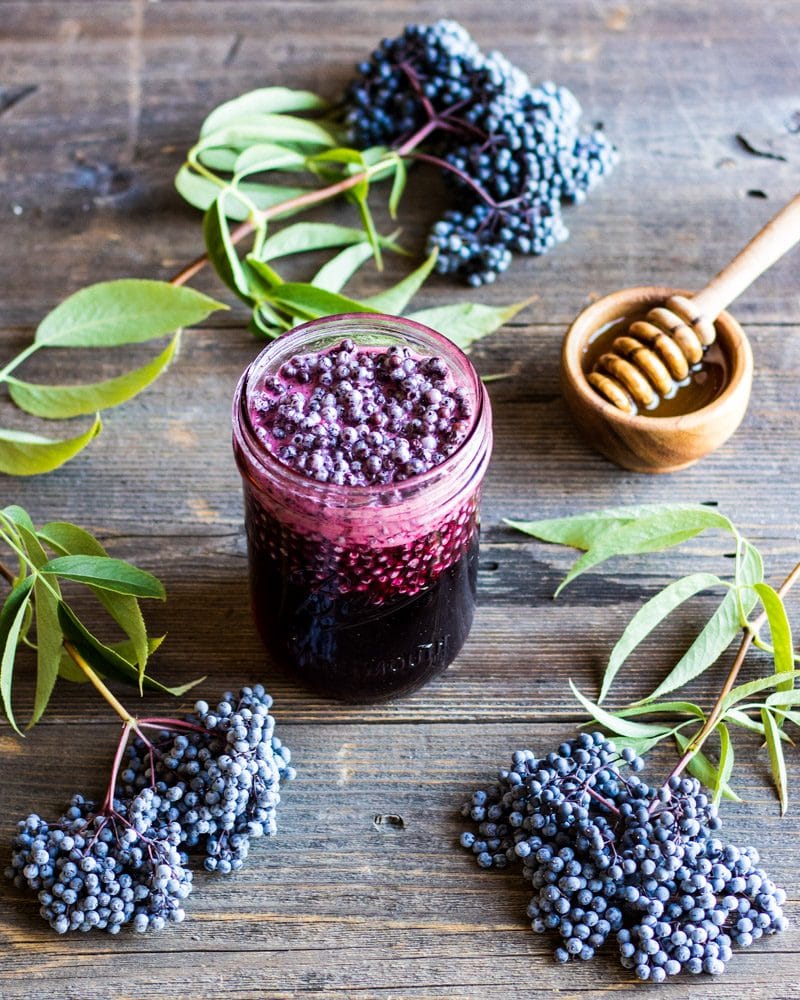
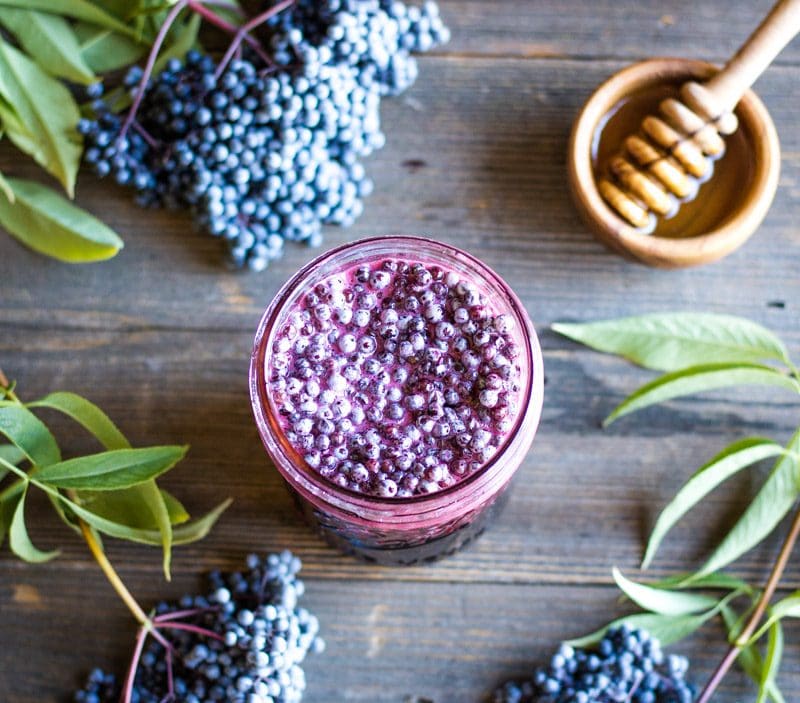
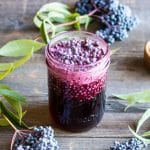

Hi! I made this but accidentally tightened the lid, so each day I released the gasses but the lid was otherwise tightened during the fermentation. Because I tightened the lid, should I be worried about botulism? Thanks!
No, it should be fine.
Hi. When rehydrating dried elderberries, do I need to dry them well? Will the batch mold if there’s a small amount of water from the rehydrated berries?
Thanks!
Hi Jennifer. After rehydrating the elderberries, I would pat them with a paper towel to soak up any pools of water trapped between them, but I wouldn’t spend too much time making sure they’re completely dry. Fresh elderberries impart their juice into the raw honey which causes it to ferment and not mold, so a little bit of excess water won’t be detrimental.
Hello, I made this recipe and my bottles were exploding. Does this need to be refrigerated after it’s made or can it be shelf stable somehow? Thank you.
It’s a good practice to burp your fermented honey every day or so to release the built-up gases. Fermented honey does not need to be refrigerated and can last up to a year in a cool, dark space away from direct sunlight.
Hi Colleen. I’ve started an elderberry and honey ferment today but notice that the berries all rise to the to…. I’ve stirred it several times….. is this normal?
Thanks for sharing your knowledge, I love your posts! Next on the list is dandelion bitters!!
Regards from New Zealand
That’s totally normal. Every day, I’ll give the jar a flip to resubmerge any berries that have floated to the top. Enjoy!
Thank you! :-)
So I’ve now found mould on top of the berry/honey mixture. It actually never fermented either. Do you have any idea what I’ve done wrong? ( I can’t add photo)
It may be that your elderberries weren’t fully submerged beneath the honey. Did you use raw (never heated) honey?
Yes, I used raw honey. Should I chuck it out?
If there is mold, yes.
Hello. I stumbled across your recipe for fermented elderberry honey while researching an answer to a mystery with my elderberry syrup. I made a simple elderberry syrup in September, using dried, reconstituted elderberries, raw honey, and spring water. When I uncapped a jar today, which has been stored in a refrigerator all these months, it had a thin, almost plastic-like film on the top, which was easily lifted off. It does smell a little tangy, but not in a bad, spoiled way. I’m wondering what this might be, and if my syrup is ruined or super infused. I have made this same syrup for years and this has never happened before. Could it have fermented? Do you have any idea and or suggestions? Thank you for your time.
Hi, Debbie. It may have started to ferment. Was there any build up pressure in the jar when you released the seal? In any case, if it doesn’t smell bad and there isn’t any mold, it should be fine.
I rehydrated my berries and they have been sitting in honey 3 weeks with tiny tiny bubbles around the top of the jar. Is this okay? Should there be more bubbling? So I need to add water? A splash of ACV? Or perhaps move to warmer place? Can I begin using my honey? Thank you so much.
The fermentation time can vary depending on the temperature of your house. I would let it ferment longer and see how it goes. Worst case is, you’ll end up with cranberry infused honey. Did you use raw, unpasteurized honey and organic cranberries?
I’m excited to try your recipe! I still have frozen elderberries from last year’s harvest. Will they work or is fresh best for the full affect? Thank you for all the great recipes!
Hi there. As long as you let them thaw for an hour or so, using frozen berries is totally fine.
I’m interested in making this. Can you please tell me, what is the fermenting process that is destroying the sambunigrin? Should I cook my elderberries first?
Hi Cheri, as long as you are using black or blue elderberries (not red) you don’t need need to cook them first. Fermentation does mitigate the toxins that are present, but I can’t say what the process is exactly, sorry!
Thank you.
I am wondering if this isn’t used up in the first year, cautiously optimistic, lol, should it be frozen. And how long would it last in the freezer. Thank you so much.
I just bought your book. I was successful with the cranberries and have garlic and elderberries going now. I appreciate your sharing your knowledge.
Hi, Cheri! Honey doesn’t need to be frozen or refrigerated. It can sit on a shelf for long periods of time with no ill effects.
thank you, this will be lovely to add a teasp to teas,,,,and a great way to use up the tons i have.
I’m so glad you liked it. It’ll be wonderful in tea!
Hello!
The elderberries in Europe don’t have that natural yeast bloom on them. Does dis mean this recipe will fail? Do you have an alternative to make this? Adding a bit of the ginger bug?
Thank you!
Hi Bo, the water content from the elderberries and the natural yeast in the honey should still make it ferment.
I have made and used elderberry/honey syrups and fermentations for over 20 years. The easiest way to avoid problems associated with berry parasites and maggots in your mixture, is to NOT use fresh, whole berries, but to make a very strong sambucus nigra decoction using 1.5 cups of dried berries and 4 cups of water. Simmer berries in the water until water volume is half. Filter the result through cheesecloth and a stainless strainer and squeeze the leavings to insure all the juice leaves the berry. Compost the used berries. Mix the decoction 2:1 decoction to honey. Jar. For syrup, refrigerate. For fermentation, leave in a dark warmish place (a low, indoor cupboard will do) and shake then relieve air pressure daily for about a month. You’ll know when it is fermented as the vinegar/alcohol taste is unmistakeable. Feed the syrup to the kiddies. Feed the ferment to the parents. Use Clarke’s method for dosing. Proportions remain consistent when doubling or tripling this recipe.
I made my first batch and it was a success! YUM!! The second batch I see little white, almost looks like seeds, floating in along with the berries. I had used fresh which I thawed and I’m wondering if it is the seeds is it still ok and will not have the toxins from the seeds in my honey. Thank you for this wonderful recipe and I will definitely be checking out your other recipes. :)
Sounds really good and I am a big fan of elderberry but 17 grams of sugar per 1 tablespoon serving is more than 4 teaspoons of sugar.. Even thou the honey is much better than processed sugar that is still crazy lot of sugar..
Hi Linda, yes honey does have 17g of sugar per tablespoon, but it is most likely the case that this fermented honey doesn’t actually have that much sugar. The good bacteria “eats” some of the sugar during the fermentation process. It’s hard to calculate things like that when a recipe is fermented, so I just go with what honey has to begin with to be on the safe side!
I am now on my second attempt batch, the first having trouble with mold. Should I consider open fermentation with cheese cloth? Maybe less elderberries.
Thanks so much for this, just made my first batch! Delicious!
I second Leona’s question… how do I store this long-term? Just leave as is, or in a jar in the fridge? Worried about the jar exploding. Thanks!
Hi Daisy! I leave mine at room temperature with the lid on a little bit loose to avoid any built up pressure and possible explosion. After a while fermentation will eventually slow way down so it won’t be too much of an issue! I’ve been fermenting things in honey for many years and have never had a jar break!
Could I cook the berries in a crockpot on low for some time then when after they cook, add them to honey?
Hello!
Got so excited about this recipe, hand picked and individually selected good looking berries but half a day in the are loads of maggots at the top of the jar… Is there any way of preventing this? If I soak the berries in water four a while first would they maintain most goodness? Would really like to try it again but don’t want to waste more honey!
Hmm, very strange! I’ve never once had that happen before with any of my honey ferments. Are you covering it with a lid so that flies and bugs can’t get in?
Yes I put the lid on! I think maybe I got unlucky with the batch… Did a little bit more research too – apparently there’s an invasive type of fruit fly that injects its eggs right into the centre of berries so they can’t be seen from the outside :-/ Trying it again with berries from a different tree. Thank you for your reply and all the recipes on this lovely site.
Hi Tamzin Too bad about the maggots! That’s Nature for ya, though… I’ve read that a quick salt-water soak will bring most bugs out of berries, it might be worth a try with your berries. There is the beneficial micro-bloom on the skin of the berries (which cultures to ferment with the honey) they say the micro-bloom can be compromised by chlorine type rinses, not sure if salt would discourage it along the same lines. Keep trying!
Thank you for sharing your knowledge. Just a few questions; You say it is shelf stable, but it can continue to ferment for months, so how do you safely store multiple jars, and to prevent exploding jars? Is it better to take the berries out before storing? Also do you have a recipe for your Elderberry Syrup? Thank you, and have a blessed day.
I’d like to use other berries, such as blueberries or raspberries to ferment the honey. Would those work?
Yes, using other berries would work!
This sounded like an absolutely wonderful option to tincture, but…..mine molded really badly. Any ideas on why it might have done that? I used fresh, clean berries and local raw honey. Thanks for any ideas.
Honey itself doesn’t mold, so I’m not sure what could have gone wrong. Was your jar cleaned properly? Were your berries completely submerged and were you rotating them periodically? Is the mold black and fuzzy?
Hi Dawn
Sorry to hear about the mold on your elderberry honey. Are you sure it was mold or could it have been kahm yeast which is a normal byproduct of fermenting.
Well, this goes on the list of things to make this year when its time to harvest my elderberries! I have enough in the freezer from last year for other uses, I can expand on the uses of elderberries this year. The fermented elderberry honey sounds amazing and without a doubt I’m sure my kids would love this too! I couldn’t get anyone in my family to eat the fermented garlic honey this winter, other than of course me because it is literally my new favorite thing to eat! So much so that my hubs and kids complained that I began to smell like a bulb of garlic ! lol I failed to see the disadvantage in that lol
How would you go about re-hydrating the elderberries if we use dried? Can we simmer the berries first and then let them cool? Would this method work to get rid of toxins since we are using heat? So it’s safe enough for young kids. I’m just worried whether it would still ferment.
Yes, you could either soak them in water or boil them for a bit if you prefer to rehydrate them. It would still ferment because of the water content from the rehydrated berries.
Could you please recommend how much water would be needed to rehydrate the dried berrys? 1 to 1 ratio? Do we discard the water afterwards? Sorry if these are ridiculous questions. Thank you in advance.
Enough water to cover them in a pot. You’ll need to discard any water leftover after they’re rehydrated.
My syrup is about ten days in and there is little to no bubbling happening. It tastes AMAZING, but not fermented. It is cold outside, but it’s warm in my house, about 70-72 degrees. Anything I can do to help it ferment? I was thinking of adding some of my Jun starter or lacto starter. Is that a thing?
Adding just a tad bit (like a spoonful) of water should help get it going! I’m not sure about adding Jun or lacto starter, never tried it!
Beautiful, and well, looks like a mixture of heavenly flavours and health. I do love elderberries, so maybe I’m a bit biased, hihi.
When you say to strain out the elderberries before use, is it because of the slightly toxic substances in them?
I love your blog, and your recipes!
Yes, mainly because it’s the seeds that contain the toxicity – although the fermentation process does take care of this issue, I still like to err on the side of caution.
I don’t have to refrigerate this, correct? Just like other honey infusion, garlic, ginger, etc.?
Right, it does not need refrigeration.
Hi, quick question!
I want to make this recipe, but include rosehips as well. Is that possible? Or should I just create a honey infusion if I want to include rosehips?
Thank you!
You could definitely include rosehips in this recipe! They are a bit dry to start the fermentation, but as long as you have the elderberries in there as well it should work just fine.
Hi! Have you tried other types of berries, such as agraz?
:)
Just cranberries! See my recipe here: Fermented Honey Cranberries
Hi there! I just preordered your book and am very excited! I have frozen elderberries in my freezer from August .. can I use those for fermented honey? And also when do you have to be fearful of bad bacteria in fermentation? Also.. sorry…. can you give this to children? (Ages 3 1/2 and 2?)
Thank you so much and am so happy I came across you!!!!
Thank you
Thank you for preordering my book! Yes you can use the frozen elderberries, but I would thaw them a bit first. This recipe is very safe and there shouldn’t be anything to worry about bacteria-wise. Just be sure that the honey coats the berries for the first few days so that mold doesn’t form (that’s why the recipe calls for inverting the jar). While the fermenting does get rid of any toxins present, traditional elderberry syrup might be safer for the little ones because it is cooked.
Many thanks for the beautiful, friendly and informative site! When you write “the fermenting does get rid of any toxins present” it makes me curious to read what you’ve read. Source, please? Thanks again!
Excited to try this. Thanks for sharing! How long would is the shelf life?
A long time! At least a year if not more.
Could I use frozen elderberries for this recipe?
Yes you can, I would thaw them a bit before combining with the honey first.
Have you used the mason tops ,pickle pipes for fermenting?
I have used items similar to those. You could use them for this recipe, but I find that capping works well because it makes the inverting process easier.
Can you use dried elderberries too? I dried mine on the counter and would like to use those. :)
Thank you
The berries need moisture in order for the honey to ferment (otherwise it’s just elderberry infused honey which is also great, but not fermented). You could try rehydrating the dried berries first and see how that works!
I rehydrated my berries and they have been sitting in honey 3 weeks with tiny tiny bubbles around the top of the jar. Is this okay? Should there be more bubbling? So I neednro add water? Can I begin using my honey?